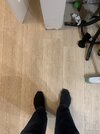Hi,
I floored my entire ground floor (almost succesfully)!
Where the wall was taken out I filled it in with compound. I tried to get it as level as possible but there is definitely movement so there’s obviously a void and unevenness.
I could potentially take it up - it’s not far from the end so could work back to it. Big job, maybe a days work….
Basically the level of the 2 floors was about 2mm out as well as the unevenness in the place where the wall was.
I am wondering - could I cut a strip out and inject some kind of filler underneath to fix it. And of course the floor could join so this would help it anyway with the 2 level issue. I’m thinking cut a small strip, fill under it somehow and put a threshold strip on top?
I suppose I could try that and if it doesn’t work take the whole thing up?
I think whatever happens it needs to be cut at and threshold strip put in because the floor heights are slightly different.
Thoughts?
I floored my entire ground floor (almost succesfully)!
Where the wall was taken out I filled it in with compound. I tried to get it as level as possible but there is definitely movement so there’s obviously a void and unevenness.
I could potentially take it up - it’s not far from the end so could work back to it. Big job, maybe a days work….
Basically the level of the 2 floors was about 2mm out as well as the unevenness in the place where the wall was.
I am wondering - could I cut a strip out and inject some kind of filler underneath to fix it. And of course the floor could join so this would help it anyway with the 2 level issue. I’m thinking cut a small strip, fill under it somehow and put a threshold strip on top?
I suppose I could try that and if it doesn’t work take the whole thing up?
I think whatever happens it needs to be cut at and threshold strip put in because the floor heights are slightly different.
Thoughts?



